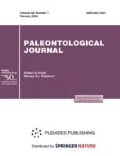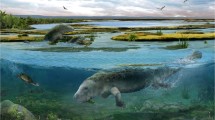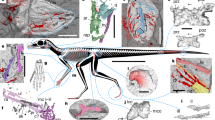Abstract
The analysis of some morphological characteristics of protoceratopoid skeletons, the extent of mobility of the vertebral column, and the probable adaptive significance of these features suggest that Bagaceratops had a mostly aquatic mode of life, Protoceratops was semiaquatic, Udanoceratops was facultatively aquatic, and Leptoceratops was predominantly terrestrial. Protoceratopoids were quadrupeds, with the prevalence of hind limbs, probably using slow or rapid trotlike gait. An asymmetrical locomotion was most likely impossible. On dry land, Bagaceratops and Protoceratops moved slowly. Udanoceratops and Leptoceratops approximately equally used rapid and slow locomotor modes, although the second could run for a longer time than the first.
Similar content being viewed by others
References
R. M. Alexander, “Estimate of Speeds of Dinosaurs,” Nature 261, 129–130 (1976).
R. M. Alexander, “Mechanics of Posture and Gait of Some Large Dinosaurs,” Zool. J. Linn. Soc. 83(1), 1–25 (1985).
R. M. Alexander, Dynamics of Dinosaurs and Other Extinct Giants (Columbia Univ., New York, 1989).
V. R. Alifanov, “Two New Dinosaurs of the Infraorder Neoceratopsia (Ornithischia) from the Upper Cretaceous of the Nemegt Depression, Mongolia,” Paleontol. Zh., No. 5, 77–88 (2003) [Paleontol. J. 37 (5), 524–534 (2003)].
V. R. Alifanov, “Surprising Horned Dinosaurs,” Priroda, No. 10, 58–69 (2005).
J. B. Bailey, “Neural Spine Elongation in Dinosaurs: Sailback or Buffalo-back?,” J. Paleontol. 71(6), 1124–1146 (1997).
R. T. Bakker, “The Superiority of Dinosaurs,” Discovery 3(2), 11–22 (1968).
R. T. Bakker, “Experimental and Fossil Evidence for the Evolution of Tetrapod Bioenergetics,” in Perspectives of Biophysical Ecology, Ed. by D. M. Gates and P. B. Schmeri (Springer, New York, 1975), pp. 365–399.
R. T. Bakker, “The Return of the Dancing Dinosaurs,” in Dinosaurs Past and Present (Nat. Hist. Mus. Los Angeles Country, Los Angeles, 1986), pp. 39–69.
R. Barsbold, “A Duel between Dinosaurs,” Priroda, No. 2, 81–83 (1974).
R. Barsbold and A. Perle, “On the Taphonomy of a Combined Burial of Juvenile Dinosaurs and Some Questions of Their Ecology,” Tr. Sovm. Sov.-Mongol. Paleontol. Eksped., No. 24 (Extinct Reptiles of Mongolia), 121–125 (1983).
B. Bohlin, “Fossil Reptiles from Mongolia and Kansu,” Sino-Swed. Exped., No. 37, 1–113 (1953).
B. Brown, “Leptoceratops, a New Genus of Ceratopsia from the Edmonton Cretaceous of Alberta,” Bull. Am. Mus. Nat. Hist. 33, 567–580 (1914).
B. Brown and E. M. Schlaikjer, “The Structure and Relationship of Protoceratops,” Ann. NY Acad. Sci. 40(3), 133–265 (1940).
B. Brown and E. M. Schlaikjer, “The Skeleton of Leptoceratops with the Description of a New Species,” Am. Mus. Novit., No. 1169, 1–15 (1942).
B. Chinnery, “Morphometric Analysis of Evolutionary Trends in the Ceratopsian Postcranial Skeleton,” J. Vertebr. Paleontol. 24(3), 591–609 (2004).
E. H. Colbert, “Evolution of the Horned Dinosaurs,” Evolution 2, 145–163 (1948).
W. P. Coombs, “Theoretical Aspects of Cursorial Adaptations in Dinosaurs,” Quar. Rew. Biol. 53, 393–418 (1978).
P. J. Currie, “Gastrolites,” in Encyclopedia of Dinosaurs, Ed. by P. J. Currie and K. Padian (Academic, San-Diego-London, 1997).
G. R. Demathieu, “Utilisation de lois de la mecanique pour l’estimation de la vitesse de locomotion des vertébrés tetrapodes du passe,” Geobios 17(4), 439–446 (1984).
G. R. Demathieu, “Nouvelles recherches sur la vitesse des vertébrés, auteurs de traces fossiles,” Geobios 19(3), 327–333 (1986).
P. Dodson, “Quantitative Aspects of Relative Growth and Sexual Dimorphism in Protoceratops,” J. Paleontol. 50(5), 929–940 (1976).
P. Dodson and P. Currie, “Neoceratopsia,” in The Dinosauria, Ed. by D. B. Weishampel, P. Dodson, and H. Osmólska (Univ. California Press, Berkeley, 1990), pp. 593–618.
P. Dodson and J. O. Farlow, “The Forelimb Carriage of Ceratopsid Dinosaurs,” in Dinofest International: Proceedings, Ed. by D. L. Wolberg, E. Stump, and G. D. Rosenberg (Acad. Natur. Sci., Philadelphia, 1997), pp. 393–398.
B. Dombrovsky, “Anticliny in Mammals and Its Functional Significance,” Zool. Zh. 14(1), 37–42 (1935).
Zh.-M. Dong and Y. Azuma, “On a Primitive Neoceratopsian from the Early Cretaceous of China,” Sino-Japanese Silk Road Dinosaur, Ed. by Zh.-M. Dong (China Ocean, Beijing, 1997), pp. 68–89.
J. O. Farlow, “Estimates of Dinosaur Speeds from a New Trackway Site in Texas,” Nature 294(5843), 747–748 (1981).
J. O. Farlow and P. Dodson, “The Behaviour Significance of Frill and Horn Morphology in Ceratopsian Dinosaurs,” Evolution 29(1/2), 353–361 (1975).
E. Frey, “Anatomie des Körperstammes von Alligator mississippiensis Daudin,” Stuttgarter Beitr. Naturkunde, Ser. A, No. 424, 1–160 (1988).
P. P. Gambaryan, Running in Mammals: Adaptive Features of Locomotor Organs (Nauka, Leningrad, 1972) [in Russian].
P. P. Gambaryan, How Mammals Run (Wiley, New York, 1974).
W. Granger and W. K. Gregory, “Protoceratops andrewsi, a Pre-ceratopsian Dinosaur from Mongolia,” Am. Mus. Novit., No. 72, 1–9 (1923).
W. K. Gregory and C. C. Mook, “On Protoceratops, a Primitive Ceratopsian Dinosaur from the Lower Cretaceous of Mongolia,” Am. Mus. Novit., No. 156, 1–9 (1925).
A. B. Howell, Speed in Animals (Univ. Chicago Press, Chicago, 1944).
S. M. Kurzanov, “A Fact from the Mesozoic,” Znanie Sila, No. 2, 26–28 (1972a).
S. M. Kurzanov, “On Sexual Dimorphism of Protoceratopoids,” Paleontol. Zh., No. 1, 104–112 (1972b).
S. M. Kurzanov, “A New Protoceratopid Genus from the Late Cretaceous of Mongolia,” Paleontol. Zh., No. 4, 91–97 (1990).
S. M. Kurzanov, “Giant Protoceratopids from the Upper Cretaceous of Mongolia,” Paleontol. Zh., No. 3, 81–93 (1992).
O. Lambert, P. Godefroit, H. Li, et al., “A New Species of Protoceratops (Dinosauria, Neoceratopsia) from the Late Cretaceous of Inner Mongolia (P.R. China),” Bull. Inst. R. Sci. Nat. Belgique, Sci. Terre, Supplement. Brussel 71, 5–28 (2001).
M. G. Lockley and A. P. Hunt, “Ceratopsid Track and Associated Ichnofauna from the Laramie Formation (Upper Cretaceous: Maastrichtian) of Colorado,” J. Vertebr. Paleontol. 15(3), 592–614 (1995).
P. J. Makovicky, “A Montanoceratops cerorhynchus (Dinosauria: Ceratopsia) Braincase from the Horseshoe Canyon Formation of Alberta,” in Mesozoic Vertebrate Life, Ed. by D. H. Tanke and K. Carpenter (Indiana Univ. Press, Bloomington, 2001), pp. 243–262.
T. Maryańska and H. Osmólska, “Protoceratopsidae (Dinosauria) of Asia,” Palaeontol. Polon., No. 33, 133–182 (1975).
K. E. Mikhailov, “How Dinosaurs Nested,” Nauka Zhizn’, No. 3, 73–79 (1997).
H. F. Osborn, “Two Lower Cretaceous Dinosaurs of Mongolia,” Am. Mus. Novit., No. 95, 1–10 (1923).
H. F. Osborn, “Psittacosaurus and Protiguanodon: Two Lower Cretaceous Iguanodonts from Mongolia,” Am. Mus. Novit., No. 127, 1–16 (1924).
H. Osmólska, “Were the Mongolian ‘Fighting Dinosaurs’ Really Fighting?,” Rev. Paléobiol., No. 7, 161–162 (1993).
G. S. Paul and P. Christiansen, “Forelimb Posture in Neoceratopsian Dinosaurs: Implications for Gait and Locomotion,” Paleobiology 26(3), 450–465 (2000).
A. S. Romer, “The Pelvic Musculature of Ornithischian Dinosaurs,” Acta Zool. 8, 225–275 (1927).
A. K. Rozhdestvensky, “New Data on Psittacosaurs, Cretaceous Ornithopods,” in Questions of Geology of Asia (Akad. Nauk SSSR, Moscow, 1955), Vol. 2, pp. 783–788 [in Russian].
A. K. Rozhdestvensky, “The Order Ornithischia,” in Fundamentals of Paleontology: Amphibians, Reptiles, and Birds, Ed. by A. K. Rozhdestvensky and L. P. Tatarinov (Nauka, Moscow, 1964), pp. 552–553 [in Russian].
L. S. Russell, “Musculature and Function in the Ceratopsia,” Nat. Mus. Can. Bull., No. 77, 39–48 (1935).
D. A. Russell, “A Skeletal Reconstruction of Leptoceratops gracilis from the Upper Edmonton Formation (Cretaceous) of Alberta,” Can. J. Earth Sci. 7(1), 181–184 (1970).
S. D. Sampson, “Speculations on the Sociology of Ceratopsid Dinosaurs (Ornithischia: Neoceratopsia),” in Mesozoic Vertebrate Life, Ed. by D. H. Tanke and K. Carpenter (Indiana Univ. Press, Bloomington, 2001), pp. 263–276.
P. C. Sereno, “Psittacosauridae,” in The Dinosauria, Ed. by D. B. Weishampel, P. Dodson, and H. Osmólska (Univ. California Press, Berkeley, 1990), pp. 579–592.
P. C. Sereno, “The Origin and Evolution of Dinosaurs,” Ann. Rev. Earth Planet. Sci. 25, 435–489 (1997).
P. C. Sereno, “The Fossil Record, Systematics and Evolution of Pachycephalosaurs and Ceratopsians from Asia,” in The Age of Dinosaurs in Russia and Mongolia, Ed. by M. J. Benton, M. A. Shishkin, D. M. Unwin, and E. N. Kurochkin (Cambridge Univ. Press, Cambridge, 2000), pp. 480–516.
E. J. Slijper, “Comparative Biologic-Anatomical Investigation on the Vertebral Column and Spinal Musculature of Mammals,” Verhandl. Koninkl. Nederl. Akad. Wetenschap., Sect. 2 42(5), 1–128 (1946).
C. M. Sternberg, “Complete Skeleton of Leptoceratops gracilis Brown from the Upper Edmonton Member on Red Deer River, Alberta,” Bull. Nat. Mus. Can., No. 123, 225–255 (1951).
V. B. Sukhanov, The General System of Symmetrical Locomotion of Terrestrial Vertebrates and Some Locomotor Features of Lower Tetrapods (Nauka, Leningrad, 1968) [in Russian].
V. B. Sukhanov, “General System of Symmetrical Locomotion of Terrestrial Vertebrates and Some Features of Movement of Lower Tetrapods” (Amerind. Publ., New Delhi, 1974).
Yu. V. Suslov, “A Burial of Psittacosaurs in Khamryn-Us (Eastern Gobi, Mongolia),” Tr. Sovm. Sov.-Mongol. Paleontol. Eksped., No. 24 (Extinct Reptiles of Mongolia), 118–120 (1983).
J. Tait and B. Brown, “How the Ceratopsia Carried and Used Their Head,” Trans. R. Soc. Can., Ser. 3 22(5), 13–23 (1928).
V. S. Tereschenko, “On the Question of the Anticliny in Lower Tetrapods,” Byull. Mosk. O-va Ispyt. Prir., Otd. Geol. 61(4), 155 (1986).
V. S. Tereschenko, “On the Reconstruction of the Vertebral Column of Protoceratops,” Paleontol. Zh., No. 2, 86–96 (1991).
V. S. Tereschenko, “On the Reconstruction of the Static Posture of Protoceratops,” Paleontol. Zh., No. 1, 85–97 (1994).
V. S. Tereschenko, “Reconstruction of the Locomotion of Protoceratops,” Paleontol. Zh., No. 2, 107–121 (1996).
V. S. Tereschenko, “Sexual Dimorphism in the Postcranial Skeleton of Protoceratopids (Neoceratopsia, Protoceratopidae) from Mongolia,” Paleontol. Zh., No. 4, 79–89 (2001) [Paleontol. J. 35 (4), 415–425 (2001)].
V. S. Tereschenko, “Morphology of the Axial Skeleton of Horned Dinosaurs (Neoceratopsia: Protoceratopoidea) from the Upper Cretaceous of Mongolia,” Candidate’s Dissertation in Biology (Paleontol. Inst. Ross. Akad. Nauk, Moscow, 2004a).
V. S. Tereschenko, “Some Adaptive Features of the Skeleton Structure of Horned Dinosaurs (Protoceratopoidea, Neoceratopsia) Mongolia,” in International Conference on the Problems of Paleontology of Central Asia (35 Years of Joint Russian-Mongolian Paleontological Expedition), May 27–28, 2004 (Paleontol. Inst. Ross. Akad. Nauk, Moscow, 2004b), pp. 60–63 [in Russian].
V. S. Tereschenko, “About Heterocelous Vertebrae in Horned Dinosaurs (Protoceratopidae, Neoceratopsia),” Paleontol. Zh., No. 2, 81–86 (2004c) [Paleontol. J. 38 (2), 200–205 (2004c)].
V. S. Tereschenko and V. R. Alifanov, “Bainoceratops efremovi, a New Protoceratopid (Neoceratopsia) from the Bain-Dzak Locality (Southern Mongolia),” Paleontol. Zh., No. 3, 71–80 (2003) [Paleontol. J. 37 (3), 293–302 (2003)].
V. S. Tereschenko and A. N. Kuznetsov, “A Method for the Determination of Intervertebral Mobility in Dinosaurs,” Paleontol. Zh. (in press).
R. A. Thulborn, “Speeds and Gaits of Dinosaurs,” Palaeogeogr., Palaeoclimatol., Palaeoecol. 38, 227–256 (1982).
R. A. Thulborn, “Preferred Gaits of Bipedal Dinosaurs,” Alcheringa 8(3–4), 243–252 (1984).
H.-L. You and P. Dodson, “Redescription of Neoceratopsian Dinosaur Archaeoceratops and Early Evolution of Neoceratopsia,” Acta Palaeontol. Polon. 48(2), 261–272 (2003).
H.-L. You and Zh.-M. Dong, “A New Protoceratopsid (Dinosauria: Neoceratopsia) from the Late Cretaceous of Inner Mongolia, China,” Acta Geol. Sin. 77(3), 299–303 (2003).
C. C. Young, “The Dinosaurian Remains of Laiyang, Shandung,” Palaeontol. Sin., New Ser. C 16(142), 1–138 (1958).
X. Xu, P. J. Makovicky, X.-L. Wang, et al., “A Ceratopsian Dinosaur from China and the Early Evolution of Ceratopsia,” Nature, No. 416, 314–317 (2002).
Author information
Authors and Affiliations
Corresponding author
Additional information
Original Russian Text © V.S. Tereschenko, 2008, published in Paleontologicheskii Zhurnal, 2008, No. 3, pp. 50–64.
Rights and permissions
About this article
Cite this article
Tereschenko, V.S. Adaptive features of protoceratopoids (Ornithischia: Neoceratopsia). Paleontol. J. 42, 273–286 (2008). https://doi.org/10.1134/S003103010803009X
Received:
Published:
Issue Date:
DOI: https://doi.org/10.1134/S003103010803009X




